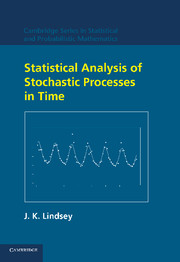Book contents
3 - Survival processes
Published online by Cambridge University Press: 03 February 2010
Summary
One of the simplest types of stochastic process involves the time until some terminating event of interest occurs, such as death of a biological organism or breakdown of a machine. Such an event signals the change into some usually irreversible state. Because of the importance of such models in medicine for the study of the survival of patients, their use is often known as survival analysis. In engineering applications, it is called reliability analysis.
Theory
As we have seen in Section 1.1.1, one possible centre of interest in studying a stochastic process may be the durations between events indicating changes of state of the process. We already have encountered, in Chapter 2, one special type of such data, in a more conventional context, the survival of marriages until divorce. There, the original state was ‘married’ and the event signalling a change was the divorce. For such durations, certain specific techniques usually will be necessary, many originally developed for the special case of survival data, but not covered in that chapters. Thus, here I shall look in more detail at some ways to model this type of process, turning to the more general case of series of several events in Chapters 4, 5, and 6.
Special characteristics of duration data
Durations between events differ from other types of responses in certain specific ways and the special case of survival data has particular characteristics of its own. It is important to look at them more closely before proceeding.
- Type
- Chapter
- Information
- Statistical Analysis of Stochastic Processes in Time , pp. 39 - 70Publisher: Cambridge University PressPrint publication year: 2004

